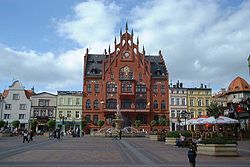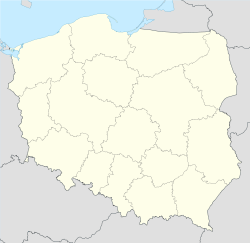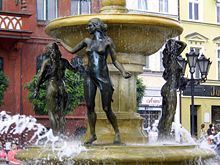- Chojnice
-
Chojnice Town Hall 
Coat of armsCoordinates: 53°42′N 17°33′E / 53.7°N 17.55°E Country  Poland
PolandVoivodeship Pomeranian County Chojnice County Gmina Chojnice (urban gmina) Established 11th century Town rights 1325 Government - Mayor Arseniusz Finster Area - Total 21.05 km2 (8.1 sq mi) Population (2006) - Total 39,716 - Density 1,886.7/km2 (4,886.6/sq mi) Time zone CET (UTC+1) - Summer (DST) CEST (UTC+2) Postal code 89-600, 89-604, 89-620 Area code(s) +48 52 Car plates GCH Website http://www.miasto.chojnice.pl Chojnice [xɔjˈnit͡sɛ] (
 listen) (Kashubian/Pomeranian: Chònice, German: Konitz) is a town in northern Poland with 39 670 inhabitants (2004), near famous Tuchola Forest, Lake Charzykowskie and many other water reservoirs. It is the capital of the Chojnice County.
listen) (Kashubian/Pomeranian: Chònice, German: Konitz) is a town in northern Poland with 39 670 inhabitants (2004), near famous Tuchola Forest, Lake Charzykowskie and many other water reservoirs. It is the capital of the Chojnice County.Chojnice is situated in the Pomeranian Voivodeship (since 1999 and before 1975). It was in Bydgoszcz Voivodeship from 1975 to 1998.
In the German language, it has traditionally been known as Conitz or Konitz. This name may be falling into disuse over time, though it can still be found in current use in Germany in some cases.
Contents
History and Timeline
Part of Eastern Pomerania, Teutonic Order, Royal Prussia, later Prussian Province of West Prussia. The center of the Kashub movement.
Duchy of Pomerelia or Eastern Pomerania (POLISH: Pommerellen)
A Najstarsza pośrednia informacja o Chojnicach zawarta jest w dokumencie wystawionym przez Mestwina II w 1275 roku augustianom z pobliskiej wsi Swornegacie. W testacji wymieniony został Mislibous Malowy de Choyniz[6], uważany za pierwszego znanego z imienia mieszkańca miasta. Już wcześniej istniał tu gród, o wybitnie obronnym położeniu na przesmyku między nieistniejącymi już jeziorami Jeleńcz i Zielonym. W roku 1309 miasto znalazło się pod władzą Krzyżaków, którzy w ciągu pierwszej połowy XIV wieku umocnili Chojnice, powiększyli obszar należący do miasta i wydali ostatecznie w roku 1360 nowy dokument lokacyjny. Teutonic Order 1309 - 1466 Chojnice indirect information is contained in a document issued by Mestwina II in 1275 Augustinians of the nearby village of Swornegacie. As was mentioned testacji Mislibous Malowy de Choyniz [6], considered the first known inhabitant of the city name. Already existed a castle, a very defensive position on the isthmus between lakes Jeleńcz already densities and Green. In 1309 the town was under the rule of the Teutonic Knights, who during the first half of the fourteenth century fortified Chojnice, expanded the area belonging to the city and eventually released in the year 1360 a new foundation document. Teutonic Order 1309 - 1466
1309 – German Teutonic Order rule: Eastern Pomerania (often known as Pomerelia), became much absorbed into the Monastic State of the Teutonic Knights 1340 - 1360 church Hl. Johannes Täufer; 14th century walls and 22 towers being erected by the Teutonic Order 1410 – Polish army occupies the town but has to return it to the Order according to the Treaty of Thorn 1417-1436 Konitz becomes an important centre for textile production 18.09.1454 – Polish army of King Kazimierz Jagiellończyk loses the Battle of Konitz 28.09.1466 – Teutonic Order has to surrender Konitz to the Polish army, after three month siege
Poland 1466 - 1772 (province of Royal Prussia)
19.10.1466 Konitz being annexed by Poland according to the 2nd Treaty of Thorn 1555 – city council accepts reformation officially, the Protestants take over the church, the Roman Catholic priest Jan Siński dies in the following turmoil 1620 – the Jesuits fight the reformation movement 10.04.1627 - town burns 18.12.1657 - town burns 1655 - 1660 war against Sweden, see Battle of Chojnice (1656) 1700 - 1721 war 15.04.1742 - town burns third time
Prussia 1772 - 1871
12.09.1772 – Konitz becomes Prussian / First partition of Poland 1864 - telegraph to Stettin
German Empire 1871- 1920 (Province of West Prussia)
15.11.1871 – railway to Schneidemühl (Piła) 1870 – Gas power plant 1873 - railway to Dirschau (Tczew) 1877 – railway to Stettin 1886 – hospital 1894 – railway to Nakel (Nakło) 1900 – water supply system and electricity power plant 1902 – railway to Berent (Kościerzyna) 1900-1902 Konitz ritual murder case & antisemitic pogrom 1909 – used water system 1912 – ,,Gazeta Chojnicka" first Polish language newspaper in town
Poland 1920-1939
31.01.1920 – Polish troops enter the town according to the Treaty of Versailles, town being renamed Chojnice 06.08.1932 – regional museum Chojnice
Third Reich 1939 - 1945 (Reichsgau Westpreußen)
01.09.1939 – 4.45 o´clock German Wehrmacht occupies Chojnice, town renamed Konitz (see Battle of Chojnice (1939)) 15.09.1939 – execution of three Poles in the city forest (Stadtwald), followed by executions of around 500 more in October and November
Poland 1945
14.02.1945 – Red Army occupies the town, 800 soldiers die, town centre heavily damaged (45%). reconstruction by Polish authorities follows. 11.07.1959 – first regular bus service after World War II 01.10.1989 – catholic church "Mother of God Queen of Poland" 2002 – new J.-K.-Łukowicz-hospital 29.08.2002 - John the Baptist becomes patron of the city of Chojnice 13.10.2003 - new catholic church "Mary of Fatima"
Population
Date Number of inhabitants 1921 10,400 1933 14,300 1948 12,400 1960 19,600 1970 23,500 1980 32,000 1990 37,700 2000 40,600 2004 39,670 The population of Chojnice has increased generally since 1901. However, events in history such as World War I and World War II reduced the town's population. This is evident in the 1921 census where the population was reduced by 300 people, due to the men having been sent to the World War I fronts and in 1920 to Poland's war against Soviet Russia. Many of them were killed, while some ethnic Germans left the town after World War I.
Again, it is evident in the 1948 census that the population was reduced by 1,900 people compared to 1933. This was due to ethnic Germans having fled or being expelled while parts of the Polish population was either forced to work in Germany or forced to leave during Nazi rule.
A census has been conducted every decade since 1948 and the results show that the population has increased, however the increase has slowed since 1980. The reasons for this are unknown though may be related to emigration of many young people to the larger towns and cities where finding a job is much easier. The next census for the town is scheduled for 2010.
People
- Nathanael Matthaeus von Wolf born here
- Willi Apel (1893–1988), German-US musicologist; born here
- Hartwig Cassel (1850–1929), journalist
- Emil Albert Friedberg (1837–1910), jurist
- Johann Ernst Gotzkowsky, a manufacturer, diplomat and art trader
- Hans Krüger, German Nazi party activist
- Rudolf Arnold Nieberding (1838–1912), jurist and politician
- Johann Daniel Titius, German astronomer
- Michał Kazimierz Radziwiłł, Polish-Lithuanian noble and magnate
- Burkhard von Schwanden, Grand Master of the Teutonic Order between 1283 and 1290
- Elisabeth (Boehm) Ronget (1893–1972), post-cubist painter
See also
- Chojnice (PKP station)
- Battle of Chojnice (1454)
- Battle of Chojnice (1656)
- Battle of Chojnice (1939)
International relations
Twin towns — sister cities
Chojnice is twinned with: Emsdetten, Bad Bevensen, Bayeux, Waalwijk, Mazyr, Korsun-Shevchenkivskyi
References
External links
- Chojnice city website
- Chojnice city portal website
- www.miastochojnice.pl
- Officers, addresses, phone numbers
- Chamber of Commerce/Tourism
- Conitz map by A. Arrowsmith. London Published 2nd Oct. 1812
- A site devoted to providing information about city history (Polish language)
Coordinates: 53°42′N 17°34′E / 53.7°N 17.567°E
Seat Chojnice (urban gmina)
Urban-rural gminas Rural gminas Gmina Chojnice Seat (not part of the gmina) Chojnice
Villages Angowice · Babilon · Bachorze · Białe Błota · Borne · Charzykowy · Chiny · Chociński Młyn · Chojnaty · Chojniczki · Chojniczki-Wybudowanie · Ciechocin · Cołdanki · Czartołomie · Dębowa Góra · Doręgowice · Drzewicz · Funka · Gockowice · Granowo · Grzampki · Jabłonka · Jakubowo · Jarcewo · Jasnowo · Jeziorki · Józefowo · Kamionka · Kamionka nad jeziorem Zamarte · Karolewo · Klawkowo · Kłodawa · Kłodawka · Klosnowo · Klucza · Kokoszka · Kopernica · Kopernica nad Jeziorem · Krojanty · Kruszka · Kulki · Lichnowy · Lipienice · Lotyń · Łukomie · Małe Swornegacie · Małe Zanie · Melanówek · Melanowo · Moszczenica · Nicponie · Nieżychowice · Nieżychowice-Wybudowanie · Nowa Cerkiew · Nowa Cerkiew Szlachetna · Nowy Dwór · Objezierze · Ogorzeliny · Osiedle Słoneczne · Ostrowite · Ostrowite ZR · Owink · Pawłówko · Pawłowo · Pawłowo-Wybudowanie · Płęsno · Pomoc · Powałki · Racławki · Sepiot · Silno · Sławęcin · Śluza · Stary Młyn · Sternowo · Strużka · Styporc · Swornegacie · Topole · Wączos · Wielkie Zanie · Władysławek · Wolność · Zbeniny · Zbrzyca
Categories:- Cities and towns in Pomeranian Voivodeship
- Chojnice County
- Shtetls
Wikimedia Foundation. 2010.





